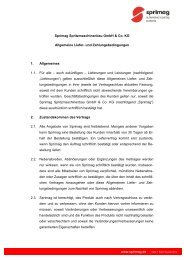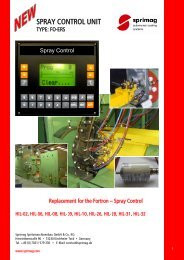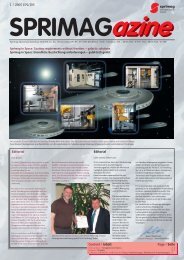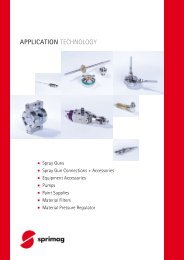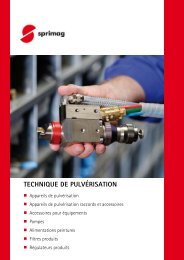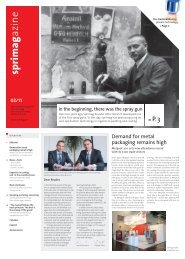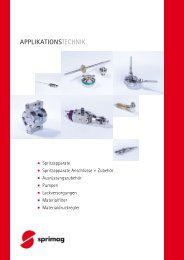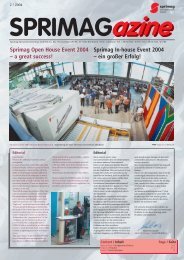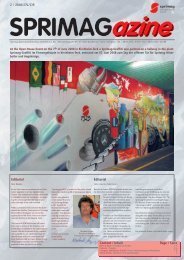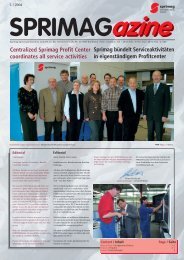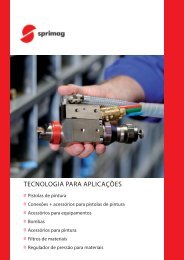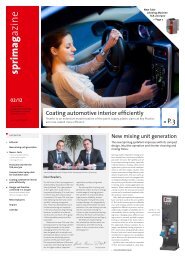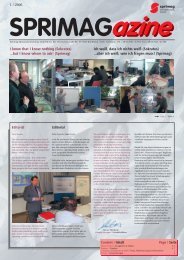2 - Sprimag
2 - Sprimag
2 - Sprimag
Sie wollen auch ein ePaper? Erhöhen Sie die Reichweite Ihrer Titel.
YUMPU macht aus Druck-PDFs automatisch weboptimierte ePaper, die Google liebt.
4<br />
Projects<br />
Flat Bed Spraying System for<br />
Plastic Components<br />
In our last edition of the SPRIMAGazine you found<br />
under the subject "Important receipt of orders” a<br />
reference to our new order for a Flat Bed Spraying<br />
Plant for a job shop in Germany. At this time we<br />
would like to offer this follow-up about the corresponding<br />
system technology: The new plant was<br />
supplied as a supplement for two existing systems<br />
and is to increase the scope of coating of plastic parts<br />
for this job shop: In future not only could small components<br />
be quoted, but also medium sized plastic<br />
components with measurements of up to 1.5 m x<br />
0.7 m x 0.1 m with a final output of up to 2 parts per<br />
minute.<br />
Despite the high output requirements and long drying<br />
times - which depend on the use of water-based<br />
lacquer systems – the design of this system used a<br />
four-level drier that afforded a short and compact<br />
footprint. We should emphasize the sophisticated<br />
horizontal air supply of the drier: inside the upper<br />
stage (which is separated from the general drying<br />
cabin and is to be understood as part of the evaporation<br />
zone) the internal air temperature can be adjusted<br />
up to max. 50 °C. Together with the increased<br />
air circulation volume within the first part of the evaporation<br />
zone, an optimal space for the evaporation<br />
and drying procedure of water-based lacquer systems<br />
is created. This additionally could be driven with an<br />
optimal energy need. At the infeed and the outlet of<br />
the lacquering cabin air supply locks were installed.<br />
The sense of locks support the main targets of air<br />
supply technology: avoiding the entry of outside dust<br />
into the whole system, avoiding of transfer of paint<br />
dust (overspray) into attached parts of the spray cabin<br />
and avoiding the entry of solvent-vapour into the flaming<br />
station installed in front of the spray cabin. This<br />
flaming station is equipped in a "Duo-Line-Burner”<br />
with a total capacity of 40 kW. The flaming station is<br />
situated as a vertically linear unit, adjustable to catch<br />
the needs of the process while coating height of parts<br />
varies. Similar to this design you will find a swivelling<br />
ionization unit in front of the flaming station that acts<br />
as the first of two pre-treatment steps. To set the<br />
design of this unit, geometry of parts was very<br />
important: distance between ionization and surface<br />
of the parts is adjusted automatically based on the<br />
height of the parts as they are identified before entering<br />
the cabin. Mainly this overall compact design is<br />
reached by the conveying technology. Central point<br />
of the conveyor is based on the respective distance<br />
between the 4 stages as this is limiting the space for<br />
installation of stages. The concept of pallets allows<br />
loading and unloading of the plant from one side of<br />
the conveyor and determines the place of setup in<br />
the workshop. The paint cabin "Flexcel” with its width<br />
of 2.5 m meets its requirements of coating plastic<br />
components with a flat bed spraying unit thanks to<br />
its special design. Even the width of the cabin shows<br />
that we came up to the user’s request for quality by<br />
offering a corresponding technical solution.<br />
These measurements not only reduce contamination<br />
of cabin walls at inlet and outlet of the booth, but<br />
also make it easier to enter into the cabin for maintenance<br />
and cleaning purposes. This was also the reason<br />
for the design of the spray axis with an extension<br />
and installation of aggregates: on one side the<br />
entry to the spraying systems was improved by<br />
mounting the axle stroke more in front (offset), and<br />
on the other side by quick-change-couplings and<br />
system clamps to make easier the change of the<br />
complete spraying system set. Part of the scope of<br />
supply is a complete supply air system with gas heating<br />
and humidification, equipped with an empty part<br />
to refit a future cooling coil. The last former part is<br />
frequently discussed in connection with dehumidification<br />
of the supply air into the cabin, which can be<br />
of help when water-based lacquers are used. In order<br />
to meet the requirements of the market concerning<br />
future system technology there were arrangements<br />
for further resources with respect to the plant control.<br />
For example it is possible to connect high grade paint<br />
supply components and atomizers which support to<br />
the production and process security of the complete<br />
plant (see separate report easyStep, easyChange on<br />
page 7).<br />
Please contact: tasso.karsch@sprimag.de<br />
Flächenspritzautomat für<br />
Kunststoffteile<br />
In der letzten Ausgabe unseres SPRIMAGazine erwähnten<br />
wir bereits in der Rubrik Bedeutende Auftragseingänge<br />
unseren neuen Auftrag über einen Flächenspritzautomaten<br />
für einen Lohnbeschichter in Deutschland.<br />
Folgende Informationen über die Anlagentechnik<br />
möchten wir Ihnen nicht vorenthalten: Die Anlage ergänzt<br />
zwei bereits bestehende Anlagen und erweitert<br />
das Leistungsspektrum des Lohnbeschichters auf dem<br />
Markt für Kunststoffbeschichtungen: zukünftig können<br />
nicht nur Kleinserien, sondern auch mittlere Serien für<br />
Kunststoffkleinteile angeboten werden. Weiterhin besteht<br />
die Möglichkeit zu Beschichtungsleistungen für<br />
Serienteile mit Abmessungen bis zu 1,5 m x 0,7 m x<br />
0,1 m bei einer erforderlichen Ausbringunsleistung von<br />
bis zu zwei Teilen pro Minute.Trotz hoher Ausbringungsleistung<br />
und beträchtlichen Trocknungszeiten –<br />
bedingt durch die Verarbeitung von wässrigen Lacksystemen<br />
– ermöglicht der mit einem 4-Etagentrockner<br />
ausgestattete Anlagentyp eine kurze und kompakte<br />
Bauweise. Hervorzuheben ist die ausgeklügelte<br />
Horizontalluftführung des Trockners: in der vom eigentlichen<br />
Trocknungsraum getrennten obersten Etage, als<br />
einem Teil der Abdunstzone, kann die Raumlufttemperatur<br />
bis maximal 50°C eigestellt werden.<br />
Zusammen mit dem erhöhten Umluftvolumen im ersten<br />
Teil der Abdunstzone ergibt sich somit ein für wässrige<br />
Lacksysteme optimierter Abdunst- und Trocknungsprozess,<br />
der zudem energieoptimiert betrieben<br />
werden kann. Vor und hinter der Lackierkabine sind<br />
Zuluftschleusen angeordnet. Der Effekt der Schleusen<br />
unterstützt die vorrangigen Ziele der Lüftungstechnik:<br />
Verhindern von Staubeintrag in das Gesamtsystem,<br />
Vermeiden von Staubübertrag (Overspray) in andere<br />
Anlagenbereiche und weitestgehende Vermeidung von<br />
Lösemittel-Dampf-Eintrag in die vorgelagerte Beflammkabine.<br />
Letztere ist mit einem Duo-Linienbrenner mit<br />
einer Gesamtleistung von 40 kW ausgerüstet. Die Anordnung<br />
der Beflammkabine an der höhenverstellbaren<br />
Lineareinheit wird den Anforderungen aus dem<br />
Teilespektrum gerecht. In der Höhenverstellung ähnlich<br />
ausgeführt ist die schwenkbare, von einer Kabine<br />
umgebenen Ionisationseinrichtung als erste der beiden<br />
Vorbehandlungsstufen. Für die Gestaltung der Einheit<br />
war die Teilegeometrie ausschlaggebend: der Abstand<br />
der Ionisation zur Teileoberfläche wird automatisch<br />
eingestellt, nachdem die Teilehöhe vor dem Kabineneinlauf<br />
detektiert wurde.<br />
Der Schwenkvorgang an sich, der um die Symmetrieachse<br />
des horizontal angeordneten Ionisationsrohres<br />
erfolgt, ist mit vergleichsweise einfachen Mitteln der<br />
ausgeführten menschlichen Handbewegung nachempfunden,<br />
wenn Teile mit topfförmigen Vertiefungen<br />
von Hand mit ionisierter Luft abgeblasen werden.<br />
Nicht zuletzt die Fördertechnik ermöglicht die kompakte<br />
Bauweise und die eingangs beschriebene Luftführung.<br />
Kernpunkt des Förderers ist der jeweilige Abstand<br />
zwischen den 4 Etagen als limitierendes Maß für<br />
die Kanaleinbauten. Das Palettenkonzept ermöglicht<br />
einerseits das Be- und Entladen der Anlage von einer<br />
Seite des Förderers und bestimmt andererseits den<br />
Aufstellungsort der Anlage in der Halle. Somit wird der<br />
Warenfluss im Unternehmen durch den Förderer in<br />
seiner Eigenschaft als Schnittstelle mitbestimmt.<br />
Die 2,50 m breite Lackierkabine "Flexcel" wird dank<br />
ihrer besonderen Ausführung den Anforderungen der<br />
Kunststofflackierung mit Flächenspritzautomaten gerecht.<br />
Allein schon die Kabinenbreite macht deutlich,<br />
dass hier dem Qualitätsanspruch des Verbrauchers<br />
ein Adäquat auf technischer Seite beigestellt wird.<br />
Durch die Abmessungen wird nicht nur die Verschmutzung<br />
der Kabinenwände am Ein- und Auslauf<br />
erheblich reduziert, sondern auch die Zugänglichkeit<br />
für Wartungs- und Reinigungsvorgänge vereinfacht.<br />
Unter ähnlicher Prämisse stand auch die Ausführung<br />
der Spritzachse mit An- und Einbauaggregaten: einerseits<br />
wird durch den vorgezogenen Achsenhub der Zugang<br />
zu den Sprühsystemen verbessert und andererseits<br />
durch Schnellwechsel-Kupplungen und Systemklemmhalter<br />
der Austausch des kompletten Sprühsystemsatzes<br />
wesentlich vereinfacht. Zur Lieferung gehört<br />
wie üblich eine Zuluftanlage mit Gasbeheizung<br />
und Befeuchtung, vorgesehen mit Leerteil zur Nachrüstung<br />
für ein Kühlregister. Letzteres ist häufig in Diskussion<br />
zur Entfeuchtung der Kabinenzuluft, die insbesondere<br />
bei Verarbeitung von wässrigen Lacksystemen<br />
nützlich sein kann. Damit mit der Anlagentechnik<br />
auch zukünftig auf die Anforderungen des Marktes<br />
reagiert werden kann, sind unter anderem die Ressourcen<br />
der Anlagensteuerung weiter ausgelegt worden.<br />
So ist z.B. die Anbindung von hochwertigen Farbversorgungskomponenten<br />
und Zerstäubersystemen möglich<br />
und trägt so gemeinsam mit der Gesamtanlage<br />
zur Produktions- und Prozesssicherung beim Kunden<br />
bei (siehe gesonderter Bericht easyStep, easyChange<br />
auf Seite 7).<br />
Kontakt: tasso.karsch@sprimag.de



